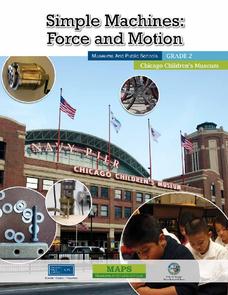Teach Engineering
Levers that Lift
Introduce your class to to the remaining three simple machines-- the lever, pulley, and the wheel-and-axle with a plan that includes the three different types of levers in the discussion of levers. The lesson continues with the...
Curated OER
Levers and Pulleys
Seventeen pages of material leave you well-prepared to carry out this lesson on levers and pulleys. Photos and diagrams make the instructions clear; resource links provide additional information. The missing aspects of this teacher's...
Teach Engineering
The Advantage of Machines
Show your students how to make their work easier. The first lesson plan in a series of 10 introduces the class to work and the way simple machines can be make work easier. The simple machines scholars can find in everyday items are...
Curated OER
First Class Lever Lab
In this first class lever worksheet, students investigate the mechanical advantage of this simple machine. Students change the effort arm and the resistance arm and calculate the resistance force, effort force and the mechanical...
Curated OER
Mechanical Advantage
In this forces worksheet, students use the mechanical advantage equation to solve for input distance or output distance. The worksheet has 17 problems to solve.
Curated OER
Simple Machines: The Wede & Lever
Learners describe how wedge and lever makes work easier. For this physics lesson, students analyze experimental data by creating a graph to see the trends. They calculate the work done and mechanical advantage of these simple machines.
Curated OER
Simple Machines Worksheet
Simplify students' lives with this physical science note-taking guide. From inclined planes to moveable pulleys, this resource supports young scientists with defining each type of simple machine while identifying their mechanical...
Curated OER
Experiments with Levers
Students investigate levers. In this simple machine lesson, students study levers and the mechanical advantage of using levers. They will collect data and illustrate their systems for eight different tests.
Curated OER
Positioning the fulcrum in class one levers
Pupils explore the relationship between force and the distance of the load from the fulcrum. In this experimental lesson plan students get into groups and make a lever and record the force that is needed to move it, they then try this...
Curated OER
Simple Machines and Mechanical Advantage
In this simple machines science worksheet, students read about simple machines, mechanical advantages, calculating mechanical advantage, output force versus input force, and distance effort versus distance of resistance. Then students...
Curated OER
The Lever Family
In this lever learning exercise, students determine the ideal mechanical advantage for different classes of levers. This learning exercise has 6 problems to solve.
Curated OER
Mechanical Advantage
For this mechanical advantage worksheet, students use the equation for mechanical advantage to solve for output force or input force. Students complete 3 problems.
Curated OER
Simple Machines and Mechanical Advantage
In this machines worksheet, students review the six simple machines and how to calculate mechanical advantage. Students complete 8 matching, 16 fill in the blank, and 6 problems to solve.
Curated OER
Levers
In this levers learning exercise, students review how to calculate mechanical advantages using forces and using distance. Students explore the three types of levers. Then students complete 20 fill in the blank questions and 6 problems to...
CK-12 Foundation
See Saw
Can a mother who weighs five times more than her child really be held in the air on a see saw by the child? A simple simulation demonstrates how this is possible through altering the distance from the fulcrum. Scholars can adjust the...
Curated OER
Is a Pulley a Special Kind of Lever?
Fifth graders use information from their text to read and discuss pulleys and levers. They examine a top sketch of the arrangement of a fixed pulley. Working in groups, 5th graders perform experiments to test the effect of using a pulley...
Curated OER
Let's Move It!
Students create a simple machine that includes a cart and lever system that could have been used to build the ancient pyramids. In this simple machine lesson, students learn about the wheel and the axle as simple machines that help...
Curated OER
Lifting a Load
Students experiments with levers to determine if the amount of force needed to lift a load is always the same. For this physics lesson, students use Lab-Pro data collector as they experiment with the fulcrum placement to measure the work...
Science Companion
Simple Machines Design Project
Make your work as a teacher a little easier with a physical science project on simple machines. After introducing young scientists to these devices and identifying their different uses around the school, this project engages children in...
Agriculture in the Classroom
Six Kinds Do It All
Teach young engineers that all machines, no matter how complicated or complex, are made up of just six simple devices with this hands-on physical science lesson. Using the included templates, students first create paper models of...
Curated OER
How Does the Elbow Work: A lesson in Levers
Students examine levers that exist in the human body. In this body function lesson students complete a lab activity that models how the elbow is a third class lever.
CPO Science
Potential and Kinetic Energy
Here's a resource ideal for independent learners who need extra reinforcement or would like to work ahead. These textbook chapters and practice problems cover many basic physics concepts, starting with potential and kinetic energy and...
Chicago Children's Museum
Simple Machines: Force and Motion
Get things moving with this elementary science unit on simple machines. Through a series of nine lessons including teacher demonstrations, hands-on activities, and science experiments, young scientists learn about forces, motion, and...
Teach Engineering
Not So Simple
Compound machines, nothing more than a combination of simple machines working together, are the focus of an activity that asks class members to use the provided information to take a look at the way innovators combine simple machines to...

























